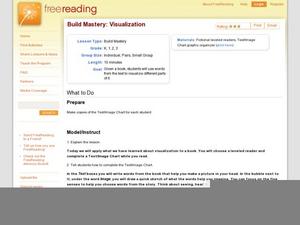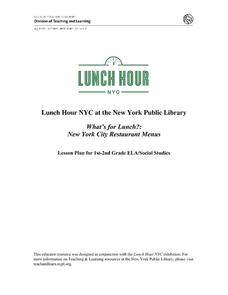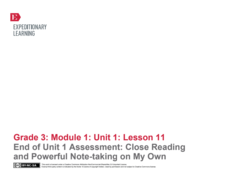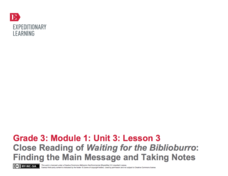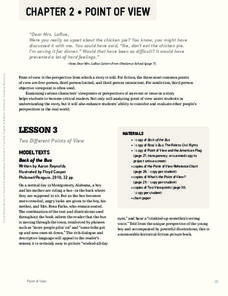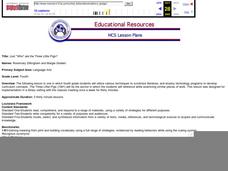Curated OER
Geeky Greeks and Robust Romans: A Look at How a Few Folks a Few Thousand Years Ago Began a Few Trends
Have a blast comparing and contrasting ancient Greek and Roman cultures with this entertaining and educational powerpoint, which is as well-organized as it is thorough. Students will find the differences between the Greeks and Romans...
Curated OER
Build Mastery: Visualization
What do you see? Young reader tap into the visualization process as they listen to or read a fiction story and fill out a graphic organizer. Model this first with a think-aloud, showing scholars how you visualize a familiar story. For...
Curated OER
Mississippi Trial, 1955: Anticipation Guide
As an introductory activity to Mississippi Trial, 1955, class members use color-coded dots to respond anonymously to a series of statements about prejudice and responsibility to their fellow-man that are posted about the room. The...
New York Public Library
What's for Lunch?: New York City Restaurant Menus
Do you remember the days when a cup of coffee cost five cents? At A.W. Dennett restaurant in 1894, you could buy a five-cent cup of coffee and as well as a five-cent slice of pie to accompany it. The menu from that year is a primary...
EngageNY
Close Reading of Nasreen's Secret School: How Do People Access Books in Afghanistan?
Third graders continue to practice the close reading skills of capturing the gist and reading again for important details in the sixth lesson in a larger unit. This is a great beginning-of-the-year unit for establishing visible thinking...
EngageNY
End of Unit 1 Assessment: Close Reading and Powerful Note-Taking on My Own
As the final lesson plan in a larger beginning-of-the-year unit to establish routines and teach close reading skills, this plan is designed as an assessment piece. Using the story, The Librarian of Basra, learners independently...
Curated OER
How to Write a Biography
Looking for a great lesson on how to write a biography? Here, middle schoolers draw from magazine articles, novels, historical figures, and current events to choose a person, or character to write about in a biography. They follow a...
Curated OER
Scary Short Story Writing Lesson
There's nothing like the prospect of writing a scary story to get your middle schoolers' writing juices flowing! In the lesson presented here, pupils listen to scary short stories read to them by the teacher. Then, a discussion ensues...
EngageNY
Close Reading of Waiting for the Biblioburro: Finding the Main Message and Taking Notes
Expose your class to Waiting for the Biblioburro, narrative nonfiction that will act as the bridge between ficiton and informational texts to come. Class members do a close reading of the text, looking at excerpts instead of the whole...
National Gallery of Canada
The Body Tells Its Story
Incorporate sculpture into your art curriculum. To start, pupils discuss the artistic process and topics of marginalization. With the discussion in mind, individuals select images to inspire sculptures of people that they will present to...
Scholastic
Point of View
The point of view in a story can dramatically change the story itself. Focus on finding the points of view in various reading passages with a language arts packet, which includes fiction and nonfiction text.
Museum of Disability
Stand Tall, Molly Lou Melon
Help to create the next generation of friends with a lesson about accepting people who are different. As kids read Stand Tall, Molly Lou Melon, they answer a series of discussion questions and activities about making friends...
Curated OER
Amos and Boris: Text Study
Twenty insightful questions follow a read aloud of the story, Amos and Boris by William Steig. Scholars then show what they know through completion of a cause and effect chart, reading fluency assessment, and a written...
Childnet International
Self Esteem
To middle schoolers, there's nothing worse than being excluded from a peer group. Developing important self-esteem skills can not only get them through awkward adolescent times, it can carry them through the rest of their lives as...
For the Teachers
Sequence Plot Chart
Your kids can identify the plot sequence of a short story, but what about an informational article? Have them examine the chronological order of events in informational texts with a activity on the sequence of events.
For the Teachers
Story Strips Sequencing
What happens next? Work on story sequence with a lesson that prompts kids to put a story back in order. Additionally, they discuss what would happen if one event was missing from the sequence.
Curated OER
The Magic Opera
Introduce your young learners to opera by dressing up as Mozart and recounting some of the fascinating details of his life and music. After exploring the Metropolitan Opera's site for kids, the class listens to a reading of Kyra...
Prestwick House
Star Wars and the Hero's Journey
Is Luke Skywalker the archetype of a literary hero? Follow the path of the Hero's Journey with an engaging lesson that details the plot structure, applies it to Star Wars: A New Hope, and invites class members to choose their own...
Roald Dahl
The Twits - Mrs Twit
"A person who has good thoughts cannot ever be ugly." The second activity in an 11-part unit that accompanies The Twits by Roald Dahl uses poetry to encourage positive character traits. Mrs. Twit has ugly thoughts, but those...
Curated OER
Map Making
Learners examine a variety of strategies to identify the structure of a story. They listen to the book Where the Wild Things Are and, as a class, complete a story element chart. Students independently read a passage from Charlotte's...
Curated OER
Problem and Solution Lesson
Students explore problems and solutions in literature. In this literature lesson, students identify problems and solutions in short guided and independent reading samples. Students also discuss characterization techniques used to develop...
Curated OER
Historical Witness: Social Messaging
Students create political cartoons that feature satire. In this political cartoon lesson, students examine examples of satire and caricature prior to creating their own political cartoons that feature the French Revolution or Industrial...
Curated OER
Just "Who" are the Three Little Pigs?
Fourth graders use a Venn diagram to compare and contrast various versions of the story The Three Little Pigs. They write a Cinquain, and then act out their version of the Three Little Pigs in a skit.
Curated OER
Novel Lesson 3
Learners examine the horrors of war through literature. In this Vietnam lesson, students read Fallen Angels and participate in discussion groups that focus on characterization and the realism of war included in the novel.

